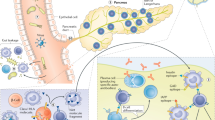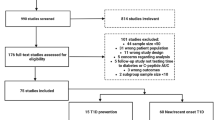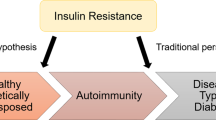Abstract
Although some 40 years have passed since type I diabetes was first defined, its cause remains unknown. The autoimmunity paradigm of immune dysregulation has not offered an explanation for its rising incidence, nor means of preventing it, and there is arguably good reason to consider alternatives. The accelerator hypothesis is a singular, unifying concept that argues that type I and type II diabetes are the same disorder of insulin resistance, set against different genetic backgrounds. The hypothesis does not deny the role of autoimmuniy, only its primacy in the process. It distinguishes type I and type II diabetes only by tempo, the faster tempo reflecting the more susceptible genotype and (inevitably) earlier presentation. Insulin resistance is closely related to the rise in overweight and obesity, a trend that the hypothesis deems central to the rising incidence of all diabetes in the developed and developing world. Rather than overlap between the two types of diabetes, the accelerator hypothesis envisages overlay—each a subset of the general population differing from each other only by genotype. Indeed, it views type I and type II diabetes as a continuum, where the infinitely variable interaction between insulin resistance and genetic response determines the age at which β-cell loss becomes critical. Adult diabetes is not viewed as an entity, but rather as diabetes presenting in adulthood. Childhood diabetes, similarly, is diabetes presenting in childhood. The increasing incidence of both is primarily the result of lifestyle change and the rise in body weight that has resulted
This is a preview of subscription content, access via your institution
Access options
Subscribe to this journal
Receive 12 print issues and online access
$259.00 per year
only $21.58 per issue
Buy this article
- Purchase on Springer Link
- Instant access to full article PDF
Prices may be subject to local taxes which are calculated during checkout





Similar content being viewed by others
References
Molbak AG, Christau B, Marner B, Borch-Johnsen K, Nerup J . Incidence of insulin-dependent diabetes in age groups over 30 years in Denmark. Diabet Med 1994; 11: 650–655.
Rosenbloom AL, Joe JR, Young RS, Winter WE . Emerging epidemic of type 2 diabetes in youth. Diabetes Care 1999; 22: 345–354.
Aizawa T, Funase Y, Katakura M, Asanuma N, Yamauchi K, Yoshizawa K et al. Ketosis-onset diabetes in young adults with subsequent non-insulin-dependency, a link between IDDM and NIDDM? Diabet Med 1997; 14: 989–991.
Gale EA . Declassifying diabetes. Diabetologia 2006; 49: 1989–1995.
Wilkin TJ . Changing perspectives in diabetes: their impact on its classification. Diabetologia 2007; 50: 1587–1592.
Wilkin TJ . The accelerator hypothesis: weight gain as the missing link between type I and type II diabetes. Diabetologia 2001; 44: 914–922.
Kibirige M, Metcalf B, Renuka R, Wilkin TJ . Testing the accelerator hypothesis: the relationship between body mass and age at diagnosis of type 1 diabetes. Diabetes Care 2003; 26: 2865–2870.
Betts P, Mulligan J, Ward P, Smith B, Wilkin TJ . Increasing body weight predicts the earlier onset of insulin-dependant diabetes in childhood: testing the ‘accelerator hypothesis’ (2). Diabet Med 2005; 22: 144–151.
Knerr I, Wolf J, Reinehr T, Stachow R, Grabert M, Schober E et al. DPV Scientific Initiative of Germany and Austria. The ‘accelerator hypothesis’: relationship between weight, height, body mass index and age at diagnosis in a large cohort of 9248 German and Austrian children with type 1 diabetes mellitus. Diabetologia 2005; 48: 2501–2504.
Kordonouri O, Hartmann R . Higher body weight is associated with earlier onset of type 1 diabetes in children: confirming the ‘Accelerator Hypothesis’. Diabet Med 2005; 22: 1783–1784.
Clarke SL, Craig ME, Garnett SP, Chan AK, Cowell CT, Cusumano JM et al. Increased adiposity at diagnosis in younger children with type 1 diabetes does not persist. Diabetes Care 2006; 29: 1651–1653.
Dabelea D, D’Agostino Jr RB, Mayer-Davis EJ, Pettitt DJ, Imperatore G, Dolan LM et al. SEARCH for Diabetes in Youth Study Group. Testing the accelerator hypothesis: body size, beta-cell function, and age at onset of type 1(autoimmune) diabetes. Diabetes Care 2006; 29: 290–294.
Rosenbloom AL . Obesity, insulin resistance, beta-cell autoimmunity, and the changing clinical epidemiology of childhood diabetes. Diabetes Care 2003; 26: 2954–2956.
Daneman D . Is the ‘accelerator hypothesis’ worthy of our attention? Diabet Med 2005; 22: 115–117.
Gale EA . To boldly go—or to go too boldly? The accelerator hypothesis revisited. Diabetologia 2007; 50: 1571–1575.
Devendra D, Liu E, Eisenbarth GS . Type 1 diabetes: recent developments. BMJ 2004; 27: 750–754.
Gepts W . Pathologic anatomy of the pancreas in juvenile diabetes mellitus. Diabetes 1965; 14: 619–633.
Nerup J, Platz P, Anderssen OO . HLA antigens and diabetes mellitus. Lancet 1974; 2: 864–866.
Bottazzo GF, Florin-Christensen A, Doniach D . Islet-cell antibodies in diabetes mellitus with autoimmune polyendocrine deficiencies. Lancet 1974; 2: 1279–1283.
Onkamo P, Vaananen S, Karvonen M, Tuomilehto J . Worldwide increase of type 1 diabetes—analysis of the data on published incidence trends. Diabetologia 1999; 42: 1395–1403.
Gale EAM . The rise of childhood type 1 diabetes in the 20th century. Diabetes 2002; 51: 3353–3361.
Shuldiner AR, Yang R, Gong DW . Resistin, obesity and insulin resistance—the emerging role of the adipocyte as an endocrine organ. N Engl J Med 2001; 345: 1345–1346.
Moller DE, Flier JS . Insulin resistance—mechanisms, syndromes, and implications. N Engl J Med 1991; 325: 938–948.
Navab M, Gharavi N, Watson AD . Inflammation and metabolic disorders. Curr Opin Clin Nutr Metab Care 2008; 11: 459–464.
Rastouli N, Kern PA . Adipocytokines and the metabolic complications of obesity. J Clin Endocrinol Metab 2008; 93 (11 Suppl 1): S64–S73.
Donath MY, Størling J, Maedler K, Mandrup-Poulsen T . Inflammatory mediators and islet beta-cell failure: a link between type 1 and type 2 diabetes. J Mol Med 2003; 81: 455–470.
Kolb H, Mandrup-Poulsen T . An immune origin of type 2 diabetes? Diabetologia 2005; 48: 1038–1050.
Pickup JC . Inflammation and activated innate immunity in the pathogenesis of type 2 diabetes. Diabetes Care 2004; 27: 813–823.
Velho C, Froguel P . Maturity-onset diabetes of the young (MODY), MODY genes and non-insulin-dependent diabetes mellitus. Diabetes Metab 1997; 23 (Suppl 2): 34–37.
Pearson ER, Flechtner I, Njolstad PR, Malecki MT, Flanagan SE, Larkin B et al. Switching from insulin to oral sulfonylureas in patients with diabetes due to Kir6.2 mutations. N Engl J Med 2006; 355: 467–477.
Sun Q, Yue P, Jeffrey A, Lumeng CN, Kampfrath T, Mikolaj MB et al. Ambient air pollution exaggerates adipose inflammation and insulin resistance in a mouse model of diet-induced obesity. Circulation 2009; 119: 538–546.
Saxena R, Gianniny L, Burtt NP, Lyssenko V, Giuducci C, Sjögren M et al. Common single nucleotide polymorphisms in TCF7L2 are reproducibly associated with type 2 diabetes and reduce the insulin response to glucose in nondiabetic individuals. Diabetes 2006; 55: 2890–2895.
Maedler K, Donath MY . Beta-cells in type 2 diabetes: a loss of function and mass. Horm Res 2004; 62 (Suppl 3): 67–73.
Robertson RP, Harmon J, Tran PO, Poitout V . glucose toxicity, lipotoxicity, and chronic oxidative stress in type 2 diabetes. Diabetes 2004; 53 (Suppl 1): S119–S124.
Wilkin TJ, Metcalf B, Jeffery A, Howdle S, Kirkby J, Voss LD . The relative contributions of birth weight, catch-up weight and current weight to the development of insulin resistance in contemporary children (EarlyBird 2). Diabetes 2002; 51: 3468–3472.
Gardner DS, Metcalf BS, Hosking J, Jeffery AN, Voss LD, Wilkin TJ . Trends, associations and predictions of insulin resistance in prepubertal children (EarlyBird 29). Pediatr Diabetes 2008; 9 (3 Part 1): 214–220.
Juneja R, Palmer JP . Type 1 1/2 diabetes: myth or reality? Autoimmunity 1999; 29: 65–83.
Gale EA . The rise of childhood type 1 diabetes in the 20th century. Diabetes 2002; 51: 3353–3361.
Zimmet P . Globalization, coca-colonization and the chronic disease epidemic: can the Doomsday scenario be averted? J Intern Med 2000; 247: 301–310.
Wilkin TJ . Early nutrition and diabetes mellitus (Editorial). BMJ 1992; 306: 283–284.
Wilkin TJ . Autoimmunity: attack or defence? Autoimmunity 1989; 3: 57–73.
Grabar P . Autoantibodies and the physiological role of immunoglobulins. Immunol Today 1983; 4: 337–340.
Roitt I, Brostoff J, Male D . Immunology. Churchill Livingstone: London, 1995, pp 1.5–1.6.
Bjork E, Kampe O, Karlsson FA, Pipeleers DG, Andersson A, Hellerström C et al. Glucose regulation of the autoantigen GAD65 in human pancreatic islets. J Clin Endocrinol Metab 1992; 75: 574–576.
Judkowski V, Krakowski M, Rodriguez E, Mocnick L, Santamaria P, Sarvetnick N . Increased islet antigen presentation leads to type-1 diabetes in mice with autoimmune susceptibility. Eur J Immunol 2004; 34: 1031–1040.
Xu P, Krischer JP, Cuthbertson D, Greenbaum C, Palmer JP . Role of insulin resistance in predicting progression to type 1 diabetes. Diabetes Care 2007; 30: 2314–2320.
Fourlanos S, Harrison LC, Colman PG . The accelerator hypothesis and increasing incidence of type 1 diabetes. Curr Opin Endocrinol Diabetes Obes 2008; 15: 321–325.
Fourlanos S, Narendran P, Byrnes GB, Colman PG, Harrison LC . Insulin resistance is a risk factor for progression to type 1 diabetes. Diabetologia 2004; 47: 1661–1667.
Hawa MI, Bonfanti R, Valeri C, Delli Castelli M, Beyan H, Leslie RD . No evidence for genetically determined alteration in insulin secretion or sensitivity predisposing to type 1 diabetes: a study of identical twins. Diabetes Care 2005; 28: 1415–1418.
Libman IM, Becker DJ . Coexistence of type 1 and type 2 diabetes mellitus: ‘double’ diabetes? Pediatr Diabetes 2003; 4: 110–113.
Tuomi T, Groop LC, Zimmet PZ, Rowley MJ, Knowles W, Mackay IR . Antibodies to glutamic acid decarboxylase reveal latent autoimmune diabetes mellitus in adults with a non-insulin-dependent onset of disease. Diabetes 1993; 42: 359–362.
Reinehr T, Schober E, Wiegand S, Thon A, Holl R . B-cell autoantibodies in children with type 2 diabetes mellitus: subgroup or misclassification? Arch Dis Child 2006; 91: 473–477.
Onkamo P, Vaananen S, Karvonen M, Tuomilehto J . Worldwide increase of type 1 diabetes—analysis of the data on published incidence trends. Diabetologia 1999; 42: 1395–1403.
Baum JD, Ounsted M, Smith MA . Weight gain in infancy and subsequent development of diabetes mellitus in childhood. Lancet 1975; ii: 866.
Johansson C, Samuelsson U, Ludvigsson J . A high weight gain in early life is associated with an increased risk of type 1 (insulin-dependent) diabetes. Diabetologia 1994; 37: 91–94.
Hypponen E, Kenward MG, Virtanen SM, Piitulainen A, Virta-Autio P, Tuomilehto J et al. Infant feeding, early weight gain and risk of type 1 diabetes. Diabetes Care 1999; 22: 1961–1965.
Bruining GJ . Association between infant growth before onset of juvenile type-1 diabetes and autoantibodies to IA-2. Netherlands Kolibrie study group of childhood diabetes. Lancet 2000; 356: 655–656.
Hypponen E, Virtanen SM, Kenward MG, Knip M, Akerblom HK, Childhood Diabetes in Finland Study Group. Obesity, increased linear growth, and risk of type 1 diabetes in children. Diabetes Care 2000; 23: 1755–1760.
Pundziute-Lyckå A, Dahlquist G, Nyström L, Arnquist H, Björke E, Blohmé G et al. Swedish Childhood Diabetes Study Group. The incidence of Type I diabetes has not increased but shifted to a younger age at diagnosis in the 0–34 years group in Sweden 1983–1998. Diabetologia 2002; 45: 783–791.
Weets I, De Leeuw IH, Du Caju MV, Rooman R, Keymeulen B, Mathieu C et al. Belgian Diabetes Registry. The incidence of type 1 diabetes in the age group 0–39 years has not increased in Antwerp (Belgium) between 1989 and 2000: evidence for earlier disease manifestation. Diabetes Care 2002; 25: 840–846.
Hermann R, Knip M, Veijola R . Temporal changes in the frequencies of HLA genotypes in patients with type I diabetes—indication of an increased environmental pressure? Diabetologia 2003; 46: 420–425.
Gillespie KM, Bain SC, Barnett AH, Bingley PJ, Christie MR, Gill GV et al. The rising incidence of type 1 diabetes is associated with a reduced contribution from high-risk HLA haplotypes. Lancet 2004; 364: 1699–1700.
Leslie RD, Taylor R, Pozzilli P . The role of insulin resistance in the natural history of type 1 diabetes. Diabet Med 1997; 14: 327–331.
Greenbaum CJ . Insulin resistance and type 1 diabetes. Diabetes Metab Res Rev 2002; 18: 192–200.
Gale EA . Spring harvest? Reflections on the rise of type 1 diabetes. Diabetologia 2005; 48: 2445–2450.
Greenbaum CJ, Eisenbarth G, Atkinson M, Yu L, Babu S, Schatz D et al. DPT-1 study group. High frequency of abnormal glucose tolerance in DQA1*0102/DQB1*0602 relatives identified as part of the Diabetes Prevention Trial. Diabetologia 2005; 48: 68–74.
Irvine WJ, McCallum CJ, Gray RS, Duncan LJ . Clinical and pathogenic significance of pancreatic-islet-cell antibodies in diabetics treated with oral hypoglycaemic agents. Lancet 1977; 1: 1025–1027.
Hathout EH, Thomas W, El-Shahawy M, Nahab F, Mace JW . Diabetic autoimmune markers in children and adolescents with type 2 diabetes. Pediatrics 2001; 107: E102.
Umpaichitra V, Banerji MA, Castells S . Autoantibodies in children with type 2 diabetes mellitus. J Pediatr Endocrinol Metab 2002; 15 (Suppl 1): 525–530.
Gilliam LK, Brooks-Worrell BM, Palmer JP, Greenbaum CJ, Pihoker C . Autoimmunity and clinical course in children with type 1, type 2, and type 1.5 diabetes. J Autoimmun 2005; 25: 244–250.
Brooks-Worrell BM, Greenbaum CJ, Palmer JP, Pihoker C . Autoimmunity to islet proteins in children diagnosed with new-onset diabetes. J Clin Endocrinol Metab 2004; 89: 2222–2227.
Ziegler AG, Hummel M, Schenker M, Bonifacio E . Autoantibody appearance and risk for development of childhood diabetes in offspring of parents with type 1 diabetes: the 2-year analysis of the German BABYDIAB Study. Diabetes 1999; 48: 460–468.
Porter JR, Barrett TJ . Braking the accelerator hypothesis? Diabetologia 2004; 47: 352–353.
Tait BD, Harrison LC, Drummond BP, Stewart V, Varney MD, Honeyman MC . HLA antigens and age at diagnosis of insulin-dependent diabetes mellitus. Hum Immunol 1995; 42: 116–122.
Bingley PJ, Mahon JL, Gale EA, The European Nicotinamide Diabetes Intervention Trial (ENDIT) Group. Insulin resistance and progression to type 1 diabetes in the European Nicotinamide Diabetes Intervention Trial (ENDIT). Diabetes Care 2008; 31: 146–150.
Wilkin TJ . Testing the accelerator hypothesis: body size, beta-cell function, and age at onset of type 1 (autoimmune) diabetes: response to Dabelea et al. Diabetes Care 2006; 29: 1462–1463.
Wilkin TJ . Insulin resistance and progression to type 1 diabetes in the European Nicotinamide Diabetes Intervention Trial (ENDIT): response to Bingley et al. Diabetologia 2008; 31: e290.
Florez JC, Jablonski KA, Bayley N, Pollin TI, de Bakker PI, Shuldiner AR et al. TCF7L2 polymorphisms and progression to diabetes in the Diabetes Prevention Program. N Engl J Med 2006; 355: 241–250.
Field SF, Howson JMM, Smyth DJ, Walker NM, Dunger DB, Todd JA . Analysis of the type 2 diabetes gene TCF7L2 in 13 795 type 1 diabetes cases and control subjects. Diabetologia 2007; 50: 212–213.
Wilkint TJ . The accelerator hypothesis cannot be tested using the type 2 diabetes gene, TCF7L2. Diabetologia 2007; 50: 1780.
Field SF, Howson JM, Walker NM, Dunger DB, Todd JA . Analysis of the obesity gene FTO in 14 803 type 1 diabetes cases and controls. Diabetologia 2007; 50: 2218–2220.
O’connell MA, Donath S, Cameron FJ . Major increase in type 1 diabetes—no support for the accelerator hypothesis. Diabet Med 2007; 24: 920–923.
Wilkin T . Major increase in type 1 diabetes: no support for the accelerator hypothesis (response to O’Connell et al). Diabet Med 2008; 25: 376–377.
Dahlquist G . The aetiology of type 1 diabetes: an epidemiological perspective. Acta Paediatr 1998; 425 (Suppl): 5–10.
Day C . Thiazolidinediones. Diabetic Med 1999; 16: 179.92.
Knowler WC, Barrett-Connor E, Fowler SE, Hamman RF, Lachin JM, Walker EA et al. Diabetes Prevention Program Research Group. Reduction in the incidence of type 2 diabetes with lifestyle intervention or metformin. N Engl J Med 2002; 346: 393–403.
Tuomilehto J, Lindström J, Eriksson JG, Valle TT, Hämäläinen H, Ilanne-Parikka P et al. Finnish Diabetes Prevention Study Group. Prevention of type 2 diabetes mellitus by changes in lifestyle among subjects with impaired glucose tolerance. N Engl J Med 2001; 344: 1343–1350.
Harlan DM, von Herrath M . Immune intervention with anti-CD3 in diabetes. Nat Med 2005; 11: 716–718.
Herold KC, Gitelman SE, Masharani U, Hagopian W, Bisikirska B, Donaldson D et al. Single course of anti-CD3 monoclonal antibody hOKT3gamma1(Ala–Ala) results in improvement in C-peptide responses and clinical parameters for at least 2 years after onset of type 1 diabetes. Diabetes 2005; 54: 1763–1769.
Dupre J, Stiller CR, Gent M, Donner A, von Graffenried B, Heinrichs D et al. Clinical trials of cyclosporin in IDDM. Diabetes Care 1988; 11 (Suppl 1): 37–44.
Wilkin T, Ludvigsson J, Greenbaum C, Palmer J, Becker D, Bruining J . Future intervention trials in type 1 diabetes. Diabetes Care 2004; 27: 996–997.
Acknowledgements
We thank the many colleagues, editors, reviewers and audiences who, by their questions and critiques, have shaped the accelerator hypothesis.
Author information
Authors and Affiliations
Corresponding author
Rights and permissions
About this article
Cite this article
Wilkin, T. The accelerator hypothesis: a review of the evidence for insulin resistance as the basis for type I as well as type II diabetes. Int J Obes 33, 716–726 (2009). https://doi.org/10.1038/ijo.2009.97
Received:
Revised:
Accepted:
Published:
Issue Date:
DOI: https://doi.org/10.1038/ijo.2009.97
Keywords
This article is cited by
-
Association of ABCC8 and KCNJ11 gene variants with type 1 diabetes in south Indians
Egyptian Journal of Medical Human Genetics (2021)
-
Current and future therapies for type 1 diabetes
Diabetologia (2021)
-
Gastric Bypass in an Adolescent with Obesity, Insulin Resistance, and Type 1 Diabetes
Obesity Surgery (2021)
-
Genotypes of HLA, TCF7L2, and FTO as potential modifiers of the association between sweetened beverage consumption and risk of LADA and type 2 diabetes
European Journal of Nutrition (2020)
-
Double or hybrid diabetes: A systematic review on disease prevalence, characteristics and risk factors
Nutrition & Diabetes (2019)



